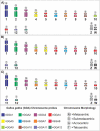Comparative chromosome painting in hummingbirds (Trochilidae)
- PMID: 33410454
- PMCID: PMC7821849
- DOI: 10.1590/1678-4685-GMB-2020-0162
Comparative chromosome painting in hummingbirds (Trochilidae)
Abstract
Hummingbirds (Trochilidae) are one of the most enigmatic avian groups, and also among the most diverse, with approximately 360 recognized species in 106 genera, of which 43 are monotypic. This fact has generated considerable interest in the evolutionary biology of the hummingbirds, which is reflected in a number of DNA-based studies. However, only a few of them explored chromosomal data. Given this, the present study provides an analysis of the karyotypes of three species of Neotropical hummingbirds, Anthracothorax nigricollis (ANI), Campylopterus largipennis (CLA), and Hylocharis chrysura (HCH), in order to analyze the chromosomal processes associated with the evolution of the Trochilidae. The diploid number of ANI is 2n=80 chromosomes, while CLA and HCH have identical karyotypes, with 2n=78. Chromosome painting with Gallus gallus probes (GGA1-12) shows that the hummingbirds have a karyotype close to the proposed ancestral bird karyotype. Despite this, an informative rearrangement was detected: an in-tandem fusion between GGA7 and GGA9 found in CLA and HCH, but absent in ANI. A comparative analysis with the tree of life of the hummingbirds indicated that this fusion must have arisen following the divergence of a number of hummingbird species.
Conflict of interest statement
Figures



References
-
- Beçak ML, Beçak W, Roberts FL, Shoffner RN, Volpe EP. Rhea americana (Rhea) 2n = 82. In: Beçak ML, Beçak W, Roberts FL, Shoffner RN, Volpe EP, editors. Chromosome atlas: Fish, Amphibians, Reptiles and Birds. Vol. 2. Springer; New York: 1973. pp. 129–207.
-
- Bleiweiss R, Kirsch JAW, Matheus JC. DNA hybridization evidence for the principal lineages of Hummingbirds (Aves: Trochilidae) Mol Biol Evol. 1997;14:325–343. - PubMed
-
- Bleiweiss R. Origin of Hummingbird faunas. Biol J Linn Soc Lond. 1998;65:77–97.
-
- Bochenski Z, Bochenski ZM. An Old World hummingbird from the Oligocene: a new fossil from Polish Carpathians. J Ornithol. 2008;149:211–216.
-
- Christidis L. Animal cytogenetics 4: Chordata 3 B: Aves. Gebrüder Borntraeger; Stuttgart: 1990. pp. 116–116.
Internet Resources
-
- Gill F, D Donsker. IOC World Bird List, 10.1. 2018. https://www.worldbirdnames.org/ioc-lists/crossref/
LinkOut - more resources
Full Text Sources

